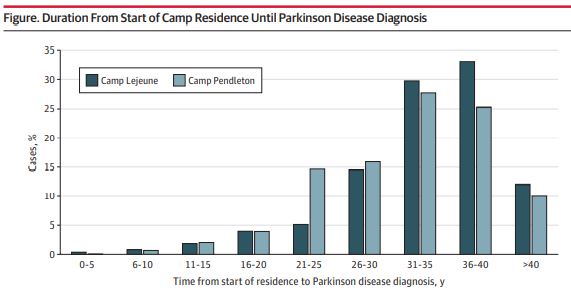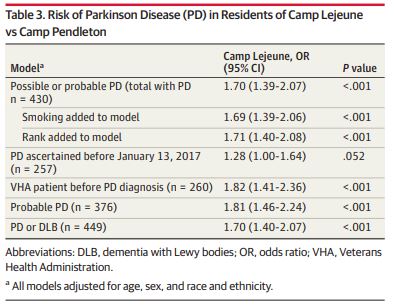SAN FRANCISCO — For veterans exposed to trichloroethylene (TCE) and other volatile organic compounds four decades ago, the risk of Parkinson’s disease is 70% higher than for veterans without those exposures, a new study suggests.
TCE is widely used as a solvent to remove grease from metal parts, and is also an ingredient in products including adhesives and paint removers. Millions of people worldwide are exposed to TCE in air, food and water. Although animal studies have supported a causal association of TCE with Parkinson’s disease and an increased risk of Parkinson’s disease has been associated with exposure to the solvent, human data have been limited to a handful of small studies and case reports.
To better understand the risk of Parkinson’s disease related to TCE exposure, VA researchers led by Samuel M. Goldman, MD, MPH, of the San Francisco VAMC examined a population with known exposure to TCE – military servicemembers who were stationed at Camp Lejeune, NC, during the mid-1970s to mid-1980s. During that period, water supplies were contaminated with several volatile organic compounds, most notably TCE, with monthly median values greater than 70-fold the permissible amount.
Their population-based cohort study, which was published in JAMA Neurology, compared the risk for Parkinson’s disease among Marines and Navy personnel who resided at Camp Lejeune for at least three months between 1975 and 1985 with servicemembers stationed during the same period at Camp Pendelton, CA, where there was no such contamination of the water supply.1
The researchers searched VHA and Medicare databases for ICD codes for Parkinson’s disease or other forms of Parkinsonism and related medications, as well as for diagnostic codes indicative of prodromal disease; Parkinson’s pathology and associated clinical features begin years before diagnosis. Parkinson’s disease diagnoses were confirmed by medical record review.
Health data were available for 158,122 – almost half – of the veterans serving in one or the other location, with personnel who served at both locations being assigned to the Camp Lejeune cohort. Demographic characteristics, including attained age, were similar for the two groups, with the Camp Lejeune cohort having slightly more women and Black members and slightly fewer Hispanic members than Camp Pendelton.
The study found that 430 veterans had Parkinson’s disease, with 279 from Camp Lejeune (prevalence, 0.33%) and 151 from Camp Pendleton (prevalence, 0.21%). In multivariable models, Camp Lejeune veterans were determined to have a 70% higher risk of Parkinson’s disease. Inclusion of smoking or military rank in logistic models had minimal impact, although Parkinson disease risk was found to be substantially lower among black veterans and ever-smokers.
Although not statistically significant, risk was also lower in Hispanic and female veterans. Pooling Parkinson’s Disease and dementia with Lewy body disease diagnoses did not affect risk estimates, and no significant associations were found for other forms of neurodegenerative parkinsonism, the researchers found.
The authors said the study is the first in their knowledge to assess the association of Parkinson’s disease and exposure to TCE-contaminated water in a large, well-powered, population-based cohort
“Remarkably, among veterans without PD, residence at Camp Lejeune was associated with a higher risk of several clinical diagnoses that are well-established prodromal features of PD,” they wrote. “Former Camp Lejeune residents had higher cumulative prodromal risk scores and were 15% more likely to score in the top 1%, suggesting they may be in a prediagnostic phase of evolving PD pathology. This observation is especially important in this relatively young cohort, given the long pathologic evolution of PD and the long latencies that have been reported for many environmental risk associations with PD.”
An Ongoing Problem
Despite being a well-established carcinogen, global consumption of TCE continues to increase, the authors wrote.
In the United States, between 9% and 34 percent of water supplies have measurable amounts of TCE, and environmental releases continue to accrue, they wrote. “Highly persistent in soil and groundwater, large subsurface TCE plumes exist throughout the world, often unbeknownst to those who live and work above them. Vapor intrusion into homes and businesses from contaminated soil is a common source of inhalational exposure and may have compounded the exposures sustained by Camp Lejeune residents through their water supply. Trichloroethylene is lipophilic and readily absorbed through respiratory, dermal, and gastrointestinal routes.”
In addition to the exposed servicemembers studied, the authors note that hundreds of thousands of family members and civilian workers exposed to contaminated water at Camp Lejeune might also be at increased risk of Parkinson’s disease, cancers, and other health consequences, adding that “continued prospective follow-up of this population is essential.”
- Goldman SM, Weaver FM, Stroupe KT, Cao L, Gonzalez B, Colletta K, Brown EG, Tanner CM. Risk of Parkinson Disease Among Service Members at Marine Corps Base Camp Lejeune. JAMA Neurol. 2023 May 15:e231168. doi: 10.1001/jamaneurol.2023.1168. Epub ahead of print. PMID: 37184848; PMCID: PMC10186205.




